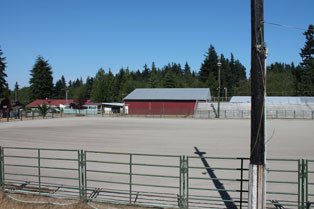Management of the Island County Fairgrounds is still the responsibility of the Island County Fair Association, for now at least.
That may change in the coming months, or even later this week, as the county’s budget director and commissioners will discuss the property’s lease agreement. Discussion is scheduled to begin 11 a.m. today in the commissioners hearing room in Coupeville.
The two parties — the county and the non-profit association — are still waiting to see what will be worked out. Diane Divelbess, president of the fair association, said her agency needs adequate funding to run the 12.8-acre property, and that their position is resolute. If they do not get financial support from Island County, they are prepared to walk away from the property and focus solely on producing the four-day fair.
“In order to put on a better fair, we just think that a different arrangement has to be made,” Divelbess said.
Don’t think the fair association’s resolve undermines their commitment to the dusty, rustic fairgrounds though.
“It’s hard to do because we’ve invested a lot of blood, sweat and tears,” she said.
In February, a steering committee of elected officials, such as Langley Mayor Fred McCarthy, county Commissioner Helen Price Johnson and Port of South Whidbey Commissioner Curt Gordon, and fair association members presented a $10.12 million plan to turn the fairgrounds from a rural ring of stables, barns, arenas and stages into a modernized event center that would be leased out year-round. The hope was that such a facility would bring in a greater and steady source of income.
But critics disagreed with its projections of drawing hundreds of thousands of visitors to the small fairgrounds, as well as its designation of several structures for demolition. That proposal now appears to be mothballed as the property’s near future gets sorted out.
Elaine Marlow, the county’s budget director whose department handles landlord duties such as the fairgrounds, said she did not expect new information to be presented from her end. She was waiting on financial information from the association about its utilities and general maintenance expenses, which she thought would not be presented until after the fair at the end of July.
“Obviously they’re busy getting ready for the fair,” Marlow said.
“My task is to look into the lease and come up with some information on the actual cost spent on the property,” she added.
Port ponders property
One of the cruxes of the fairgrounds’ future is what the Port of South Whidbey decides. In late June, Island County Commissioner Jill Johnson asked the port district to consider taking over the property’s management. Port commissioners spent part of their July 8 meeting talking about running the fairgrounds. Port Commissioner Ed Halloran, who represents Langley, said they were no closer to a decision than they were last month.
“I think people are going to have to be patient,” Halloran said, adding that as a first-year port commissioner he is still learning about the district.
His novice status on the port board did not keep him from explaining that the district would need to hire someone if it indeed assumed the property.
“It’s a big, big request for the port to do anything more than be one of the components,” Halloran said. “But to even start to hint about managing that thing, I think it’s clear that it’s unmanageable.”
Were the port to assume management of the property and its aging buildings, many of which were claimed by proponents of the fairgrounds overhaul to be beyond repair, it would leave the fair’s production to someone else. A driving reason for the port to even consider something with few maritime ties is the district’s mission to “enhance the economic well-being of the community.”
Even that part of the now-stalled fairgrounds proposal was hotly debated in public presentations. Some people decried the possible increase in traffic given the revamped fairgrounds’ productivity. For the fairgrounds to make money, it needed to host events nearly every week of the year. Halloran said he had concerns about making the fairgrounds, as they exist now, marketable for revenue-generating events other than the Whidbey Island Area Fair.
“The fair is terrific,” Halloran said. “It meets all of the needs of the community. But what are you going to do the other 50 weeks?”
Funding is a major concern of port leaders. The district has a small staff that runs eight locations on South Whidbey, many of them boat launches and waterfront parks. Its taxing authority is defined as all of South Whidbey, essentially from Mutiny Bay Road’s northern extent to Possession Point. Having the port as its landlord was OK with the fair association, as long as the district could adequately maintain the property and its buildings.
“The thing is, the port has a limited taxing authority, which we don’t have as a fair association,” Divelbess said. “Whether that’s sufficient for them to tackle this, only time will tell … . At least they might be in a position to say, ‘Let’s talk.’ ”
Getting the county to commit more money and a dedicated staff person to run the property would help make the property more profitable, Divelbess said.
“Everybody on the island wants the fairgrounds to continue to exist and to maintain its heritage, its charm and usability,” she said. “To get more help from the county, its usability would increase.”
Halloran said the county has some soul-searching of its own to tackle. He noted that there is a new interim commissioner, and that by next year, another commissioner may be in his place. Depending on who is voted in, Halloran said, could greatly impact the county’s dedication to figuring out what to do with the fairgrounds.



